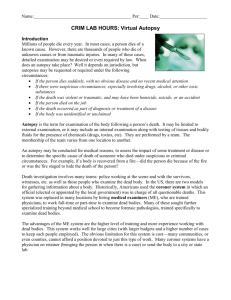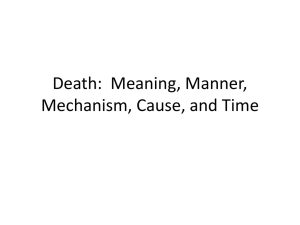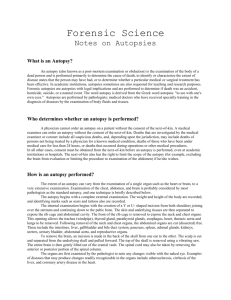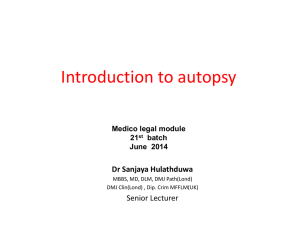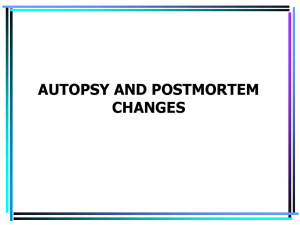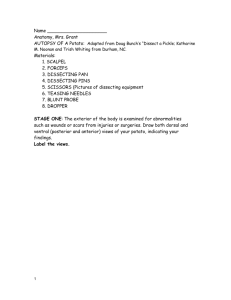attitude and knowledge of medical students on practical aspects of
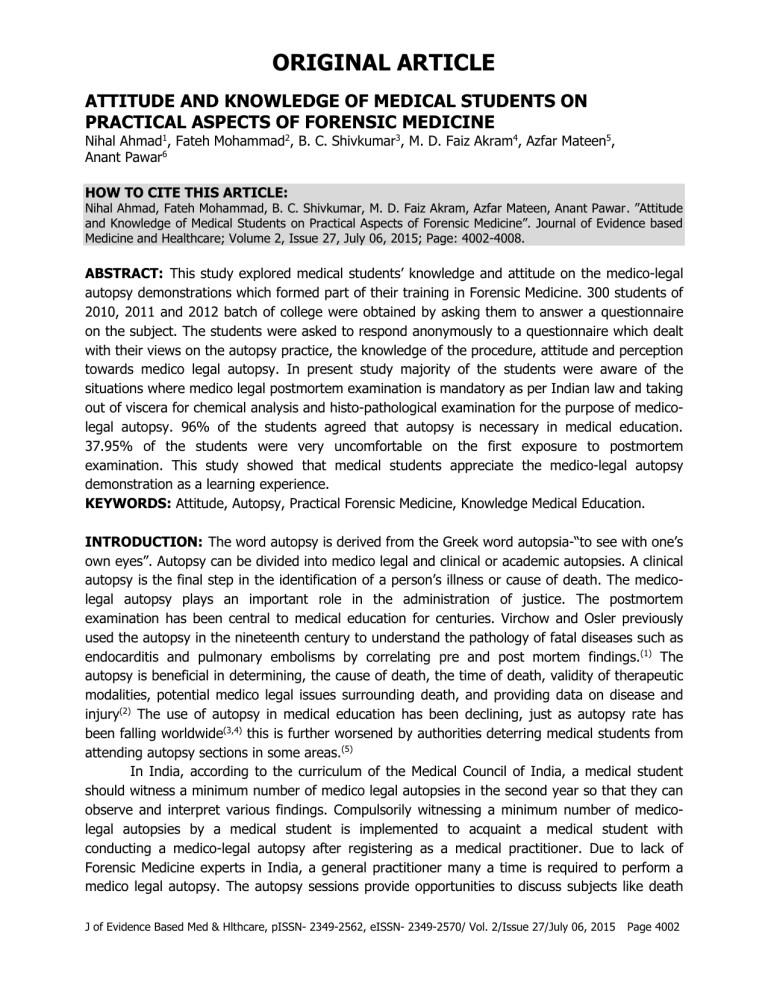
ORIGINAL ARTICLE
ATTITUDE AND KNOWLEDGE OF MEDICAL STUDENTS ON
PRACTICAL ASPECTS OF FORENSIC MEDICINE
Nihal Ahmad 1
Anant Pawar 6
, Fateh Mohammad 2 , B. C. Shivkumar 3 , M. D. Faiz Akram 4 , Azfar Mateen 5 ,
HOW TO CITE THIS ARTICLE:
Nihal Ahmad, Fateh Mohammad, B. C. Shivkumar, M. D. Faiz Akram, Azfar Mateen, Anant Pawar. ”Attitude and Knowledge of Medical Students on Practical Aspects of Forensic Medicine”. Journal of Evidence based
Medicine and Healthcare; Volume 2, Issue 27, July 06, 2015; Page: 4002-4008.
ABSTRACT: This study explored medical students’ knowledge and attitude on the medico-legal autopsy demonstrations which formed part of their training in Forensic Medicine. 300 students of
2010, 2011 and 2012 batch of college were obtained by asking them to answer a questionnaire on the subject. The students were asked to respond anonymously to a questionnaire which dealt with their views on the autopsy practice, the knowledge of the procedure, attitude and perception towards medico legal autopsy. In present study majority of the students were aware of the situations where medico legal postmortem examination is mandatory as per Indian law and taking out of viscera for chemical analysis and histo-pathological examination for the purpose of medicolegal autopsy. 96% of the students agreed that autopsy is necessary in medical education.
37.95% of the students were very uncomfortable on the first exposure to postmortem examination. This study showed that medical students appreciate the medico-legal autopsy demonstration as a learning experience.
KEYWORDS: Attitude, Autopsy, Practical Forensic Medicine, Knowledge Medical Education.
INTRODUCTION: The word autopsy is derived from the Greek word autopsia-“to see with one’s own eyes”. Autopsy can be divided into medico legal and clinical or academic autopsies. A clinical autopsy is the final step in the identification of a person’s illness or cause of death. The medicolegal autopsy plays an important role in the administration of justice. The postmortem examination has been central to medical education for centuries. Virchow and Osler previously used the autopsy in the nineteenth century to understand the pathology of fatal diseases such as endocarditis and pulmonary embolisms by correlating pre and post mortem findings.
(1) The autopsy is beneficial in determining, the cause of death, the time of death, validity of therapeutic modalities, potential medico legal issues surrounding death, and providing data on disease and injury (2) The use of autopsy in medical education has been declining, just as autopsy rate has been falling worldwide (3,4) this is further worsened by authorities deterring medical students from attending autopsy sections in some areas.
(5)
In India, according to the curriculum of the Medical Council of India, a medical student should witness a minimum number of medico legal autopsies in the second year so that they can observe and interpret various findings. Compulsorily witnessing a minimum number of medicolegal autopsies by a medical student is implemented to acquaint a medical student with conducting a medico-legal autopsy after registering as a medical practitioner. Due to lack of
Forensic Medicine experts in India, a general practitioner many a time is required to perform a medico legal autopsy. The autopsy sessions provide opportunities to discuss subjects like death
J of Evidence Based Med & Hlthcare, pISSN- 2349-2562, eISSN- 2349-2570/ Vol. 2/Issue 27/July 06, 2015 Page 4002
ORIGINAL ARTICLE certification, Forensic Pathology, appropriate attitudes towards deaths and communication skills essential for giving bad news or seeking consent for autopsy.
(6)
It is only when students attend an autopsy section that they can appreciate the large number of pathological conditions in different patients. The value of autopsy (Clinical/Medico legal) has been proven in its elucidation of the cause of death, clinical quality control, medical auditing and in medical education.
(7,8) Various reasons given for the decline in autopsy-based teaching include insufficient hospital autopsies, competing departmental duties and limited curriculum time.
(9)
The need to expose the students to autopsy cannot be over emphasized because eventually these students will become clinicians and as clinicians they are not likely to advocate autopsies if they have not been properly exposed to the same. It is obvious that knowledge of autopsy will broaden the students’ mind and enhance a more accurate diagnosis during the subsequent years of their clinical practice as doctors.
Many medical students graduate without seeing an autopsy (10) but in some countries they may be the only medically qualified person to undertake the task. In India, for example, according to the curriculum of the Medical Council of India, a medical student should witness medico legal autopsies in the second and third year of MBBS so that they can observe and interpret the various changes in organs and tissues. An intern is supposed to acquire the skill of doing a medico-legal autopsy. Thus, every medical graduate is presumed to be capable of doing a medico-legal autopsy.
(11)
Very few studies have been conducted on the attitudes of medical students to clinical autopsy/medico legal autopsy. The aim of this study is to investigate the general attitude of medical students of 2nd, 3rd and 4th years towards medico-legal autopsy/Clinical autopsy.
AIMS AND OBJECTIVES: To study the attitude of medical students towards autopsy specifically medico-legal autopsy.
MATERIAL METHODS: This study was conducted among medical students of a private medical college of India at Kerala. Comments of the students of 2010, 2011 and 2012 batch of medical college were obtained by asking them to answer a questionnaire on the subject.
Questionnaires were prepared, after consulting other faculty members of the dept. going through literature and day today interactions with students during autopsy.
The questionnaires were distributed to the students and participation in the study was voluntary. The students were asked not to disclose their identity. Their comments were analyzed in detail on the following aspects: usefulness and necessity of autopsy in medical practice and education; their personal distaste for the procedure, whether attendance at an autopsy should remain a compulsory part of medical education, staff attitudes, observance of relative’s wishes; and feelings about autopsies carried out on self or relatives. A total of 300 students participated in the study.
RESULT: All the students were having a positive view regarding the role of postmortem examination in delivering the justice. (Table 1)
J of Evidence Based Med & Hlthcare, pISSN- 2349-2562, eISSN- 2349-2570/ Vol. 2/Issue 27/July 06, 2015 Page 4003
ORIGINAL ARTICLE
Is postmortem examination is needed in all cases of sudden, unnatural death?
Utility of using viscera for histo-pathological examination and toxicological analysis for medico legal autopsy.
The purpose of doing
Postmortem examination
The reaction of the students on the first exposure to postmortem examination
Yes=90%(n=270)
No= 9%(n=27)
Ignorant=1%(n=3)
Yes= 96%(n=288)
No =3%(n=9)
Ignorant=1%(n=3)
Done to know the cause of death=99%(n=297)
Mere legal formality=18.66%(n=56)
Harassment to the relatives of the deceased=3.67%(n=11)
Helpful in reaching the culprit of crime=89%(n=267)
Comfortable. n=21(10.77%)
Slightly uncomfortable. n=74(37.95%)
Moderately uncomfortable. n=26(13.33%)
Very uncomfortable. n=63(32.30%)
Indifferent. n=11(5.64%)
Yes =62.3%(n=187)
No=37.67%(n=113)
Are the number of cases witnessed by students is enough
Students should watch more postmortem examination
Given a chance would you choose not to watch P.M examination at all?
The utility of P.M examination in medical education.
Whether postmortem examination causes disfigurement of body?
Whether doing Postmortem examination is disrespect to human body?
Should autopsy be scrapped from the medical curriculum
Reasons for Not Specializing in
Forensic Medicine
Yes=87.67%(n=263)
No=12.37%(n=36)
Yes=17%(n=51)
No=83%(n=249)
Yes=96%(n=288)
No=4%(n=12)
Yes=27%(n=81)
No=73%(n=219)
Yes=9%(n=27)
No=91%(n=273)
Yes=97.66%(n=293)
No=2.33%(n=7)
Not interested in Forensic Medicine (30%)
Interested in other specialties (60%)
Not lucrative, Scope in India is minimal (3%)
No reasons (10%)
J of Evidence Based Med & Hlthcare, pISSN- 2349-2562, eISSN- 2349-2570/ Vol. 2/Issue 27/July 06, 2015 Page 4004
ORIGINAL ARTICLE
Improvement in hygiene and sanitation in autopsy room (65%)
More involvement of autopsy surgeon during autopsy
(15%) Suggestions for Improvement in Autopsy Procedure Replacement of primitive instruments with modern ones in the autopsy room (76%)
Active participation of students during autopsy (60%)
Show more respect towards dead body (40%)
Yes=84% Casualty posting specifically for Forensic Medicine for trauma, poisoning and other medico-legal cases.
If the need arises, will they allow postmortem examination on them or their relatives
No=16%
Yes=55.67%(n=167)
No=44.37%(n=133)
Table 1
DISCUSSION: Autopsy is the procedure detrimental in accurately establishing the cause and manner of death in both clinical and forensic cases. Autopsies also allow confirmation of ante mortem diagnosis, as well as the identification of new and re-emerging diseases, and thus they are important in both protecting the public health and improving the accuracy of vital statistics.
(12)
In the present study, all the students witnessed a minimum of ten autopsies each. 62.3%
(n=187) of the students said that the number of autopsies they witnessed were enough, 87.67%
(n=263) students recommended that medical students should watch more autopsies. This is similar to the study by Ekanem and Akhibe, (13) where the figure was 57% and 74% respectively.
Most of the students, 96% (n=288) agreed that autopsy is necessary and they learnt something from watching and participating in an autopsy. The knowledge of the physiological processes in disease states is better illustrated with autopsies.
(14)
This compares favorably with the studies of other authors.
(15-17) In Nigeria several students commented that attendance at autopsy may have fundamental psychological benefits, “aiding students to come to terms with the death of a patient,” and “attending one or more autopsies is good for medical students in that it is one way in which we can come to terms with mortality.” (18)
In our study only 55.67% agreed to an autopsy being performed on them. Which is similar to the study by Ekanem and Akhibe, (13) where only 34% agreed to autopsy being performed on themselves, and is in contrast to the studies by Sanner (17) in Sweden, and Jadav CJ et al (19) in which 90% and 82.5% of the students respectively agreed for autopsy to be performed on themselves, though most of them felt uncomfortable at the thought of it.
The majority, (166, 55.3%), suggested that students should actively participate in performing autopsies rather standing and watching as mute spectators. The same view was expressed by the students (76%) in a study conducted by Ekanem and Akhibe.
(13) 40%
J of Evidence Based Med & Hlthcare, pISSN- 2349-2562, eISSN- 2349-2570/ Vol. 2/Issue 27/July 06, 2015 Page 4005
ORIGINAL ARTICLE respondents felt that inadequate respect had been shown to the dead. They were of the view that the autopsy was done very quickly; chisels and hammers were indiscriminately used to open the body cavities.
76% students suggested that primitive instruments such as chisel, hammer and saw should be replaced with modern oscillatory electric saw in the autopsy room.
The majority of the students (30%) were not interested in specializing in Forensic
Medicine because it deals with death, while 60% of them had made up their mind to specialize in other specialties. 3% of them felt that forensic medicine as a profession is not lucrative, because there is very little scope at present in India for this specialty. Though no other study has been exclusively done on this subject i.e. medico legal autopsy, a similar study by Ekanem and
Akhibe (13) on the clinical autopsy compares favorably with the present study.
CONCLUSION: The need to expose medical students to autopsy cannot be over emphasized because eventually these students will be doing the postmortem cases. The knowledge of autopsy procedure will broaden the student’s perceptive and will help the legal system in delivering quick justice in criminal cases. However, most of the mortuaries in India are in a primitive state and do not encourage the student to become more interested in observing autopsies. Unpleasant aspects of an autopsy demonstration should be kept to a minimum to encourage attendance and promote a sense of its value, and that it might be useful to influence and modify students’ opinions. The students’ emotional reactions are important, but unfortunately neglected aspect of medical training. The dissection of a dead body is not simply a technical exercise; it raises emotional feelings with regard to human mortality and dignity. Overall, this study supports those studies conducted with a quantitative methodology, which indicate that the necropsy is of value in medical education.
This study showed that medical students still appreciate the medico-legal autopsy demonstration as a learning experience. In present study majority of the students were aware of the situations where medico-legal autopsy and preservation of viscera for chemical analysis and histopathological examination is mandatory as per Indian law. All the students answered in positive about postmortem examination involves examination of body externally and internally which is favored by the study by Verma S.K.
(16) as it is compulsory to attend postmortem examination as a part of their undergraduate teaching.
REFERENCES:
1.
Hume M. Pulmonary embolism: historical aspects. Arch Surg 1963; 87: 709–714.
2.
Brooks JP, Dempsey J. How can hospital autopsy rates be increase 1? Arch Pathol Lab Med
1991; 115: 1107-11.
3.
Lowry F. Failure to perform autopsies means some MDs “walking in a fog of misplaced optimism.” CMAJ 1995; 15: 811-14.
4.
Galloway M. The role of autopsy in medical education. Hosp Med 1999; 60: 756-8.
5.
Anderson RE, Hill RB. The current status of the autopsy in academic medical Centre’s in the
United States. Am J Clin. Pathology 1989; 92: 531-7.
6.
Charlton R. Autopsy and medical education: a review. J R Soc Med. 1994 Apr; 87(4):232-6.
J of Evidence Based Med & Hlthcare, pISSN- 2349-2562, eISSN- 2349-2570/ Vol. 2/Issue 27/July 06, 2015 Page 4006
ORIGINAL ARTICLE
7.
Teo CE. The autopsy. Singapore Med J 1997; 38: 71-5.
8.
Diegbe IT, Idaewor PE, Igbokwe UO. Autopsy audit in a teaching hospital in Nigeria- the
Benin experience. West Afr. J Med 1998; 17: 213-6.
9.
Hill RB, Anderson RE. The uses and value of autopsy in medical education as seen by pathology educators. Acad Med 1991; 66: 97-100.
10.
Verma SK. teaching students the value of autopsies. Acad Med 1999; 74: 855.
11.
Medical Council of India. Regulations on graduate medical education 1997. New Delhi: MCI
1997; 28-9.
12.
Lundberg GD. Low-tech autopsies in the era of high-tech medicine: continued value for quality assurance and patient safety. JAMA. Oct 14 1998; 280(14): 1273-4.
13.
Ekanem VJ, Akhigbe KO. Attitudes of Nigerian medical students to autopsy. Turk J Med Sci
2006; 36: 51-6.
14.
Loughrey MB, McGluggage WG, Toner PG. The declining autopsy rate and clinicians’ attitudes. Ulster Med J 2000; 69(2): 83-9.
15.
Botega NJ, Metze K, Marques E, Cruvinel A, Moraes ZV, Augusto L, et al. Attitudes of medical students to necropsy. ClinPathol 1997; 50: 64-6.
16.
Verma S.K. Knowledge and attitude of medical students in Delhi on postmortem examination 1999, Indian J Med Sci Aug; 53(8): 352-8.
17.
Sanner MA. Medical student’s attitudes toward autopsy. How does experience with autopsies influence opinion? Arch Pathol Lab Med., 119: 851-8, 1995.
18.
Conran P, Nowacek G, Adams T et al. Medical students’ attitudes towards the autopsy. Acad
Med., 71: 681-3. 1996.
19.
Jadav JC, Patel BN, Shah KA, Tandon RN. Knowledge and attitude of medical students on
Forensic Autopsy in Ahmedabad city. J Indian Acad Forensic Med. Jan-March 2013; 35 (1):
26-28.
J of Evidence Based Med & Hlthcare, pISSN- 2349-2562, eISSN- 2349-2570/ Vol. 2/Issue 27/July 06, 2015 Page 4007
ORIGINAL ARTICLE
AUTHORS:
1.
Nihal Ahmad
2.
Fateh Mohammad
3.
B. C. Shivakumar
4.
M. D. Faiz Akram
5.
Azfar Mateen
6.
Anant Pawar
PARTICULARS OF CONTRIBUTORS:
1.
Associate Professor, Department of
Forensic Medicine, KMCT Medical
College, Calicut, Kerala.
2.
Associate Professor, Department of
Anatomy, KMCT Medical College,
Calicut, Kerala.
3.
Professor & HOD, Department of
4.
Forensic Medicine & Toxicology,
Sapthagiri Institute of Medical
Sciences & Research Center,
Bangalore.
Associate Professor, Department of
Pharmacology, KMCT Medical College,
Calicut, Kerala.
5.
Lecturer, Department of Forensic
Medicine, MRA Medical College,
Ambedkar Nagar, U. P.
6.
Professor & HOD, Department of
Preventive and Community Medicine,
KMCT Medical College, Calicut, Kerala.
NAME ADDRESS EMAIL ID OF THE
CORRESPONDING AUTHOR:
Dr. Nihal Ahmad,
Department of Forensic Medicine,
KMCT Medical College,
Manassery, P. O. Mukkam,
Calicut, Kerala.
E-mail: drnihalahmed@gmail.com
Date of Submission: 23/06/2015.
Date of Peer Review: 24/06/2015.
Date of Acceptance: 02/07/2015.
Date of Publishing: 06/07/2015.
J of Evidence Based Med & Hlthcare, pISSN- 2349-2562, eISSN- 2349-2570/ Vol. 2/Issue 27/July 06, 2015 Page 4008


